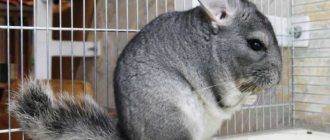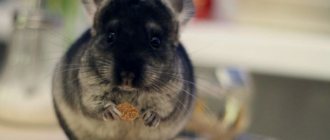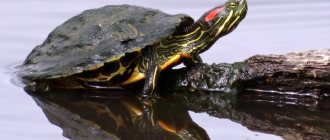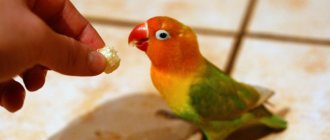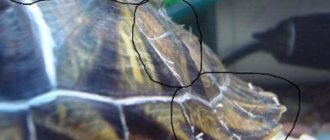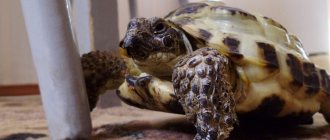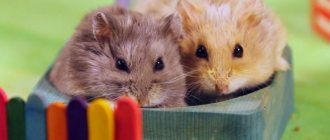Animal feed
It is best to build a diet based on animal food. The reptile's menu consists of 60% or more animal protein .
A turtle will happily eat any meat, but it is preferable to feed it lean varieties: beef, rabbit or poultry .
Attention! It’s a good idea to diversify your pet’s diet with fish, beetles and plants.
Meat
The aquarium red ear eats meat with pleasure, but how to feed it correctly and how many times a day so as not to harm it?
The basis of the diet is necessarily lean meat . Fatty lamb and pork will lead to digestive problems, illness and even death of the pet. In addition to the protein itself, the diet should contain by-products:
- heart;
- liver;
- stomachs.
You can occasionally feed your turtle small mice.
Important! A diet of only unprocessed meat is a direct path to vitamin A deficiency and rickets. You need to diversify the list of products, then your pet will be healthy.
What kind of fish is suitable for food?
What fish should you feed your red ear? As with meat, you need to choose lean varieties. First remove bones that can harm the turtle, as well as entrails and scales.
In addition, before serving, it is recommended to dip the fish in boiling water for a couple of minutes so that the thiaminase enzyme coagulates.
A cocktail made from sea creatures would be a good addition to your diet , but you shouldn’t give it often.
Attention! The redfish will not get along in an aquarium with fish and snails - this is its natural food supply.
Insects
What do red-eared turtles eat besides food? You will be surprised - insects! In summer they add to the menu:
- grasshoppers;
- caterpillars;
- bloodworm;
- mealworm;
- gammarus;
- daphnia (but in this case it is better to turn off the filter for a while).
Other animal food options
You should not feed your turtle caught cockroaches or spiders.
Insects can be “stuffed” with toxic substances, which will certainly harm your pet.
What to feed baby turtles
What can you feed a small red-eared turtle in captivity? After all, it is important that baby reptiles have full development and good health right from the first days. And their well-being directly depends on a balanced diet.
When creating a menu for small turtles, you should consider the following important recommendations:
- the diet should consist of balanced and varied components;
- It is better to give the cubs more food of animal origin;
- Sea or river fish is considered healthy, it should be almost 80% of the menu;
- the remaining 20% should be crustaceans, offal, mollusks, insects;
- You can add guppies, mollies, and swordtails to your kids’ aquarium.
Plant food
The diet of an adult turtle should be dominated by plant components . The older she is, the more vegetarian dishes are on the menu.
Grass
Little Reds eat their coltsfoot with gusto. Also great for:
- leaves of plantain, clover, dandelions;
- sprouted oats and barley.
Aquarium plants
Seaweed is a good addition to the menu. Duckweed, watercress and any plants from natural bodies of water are suitable
Vegetables
Turtles love kibble:
- bell peppers;
- zucchini;
- eggplant;
- cucumbers;
- tomatoes;
- carrots;
- beets;
- pumpkins.
Mushrooms
Once a week, champignons, russula or boletus , cut into small pieces, are added to the regular diet.
What are red-eared turtles?
Increasingly, the red-eared turtle is becoming a popular pet. The animal received its name due to a specific feature - red spots, which are located on the sides of the eyes and are visible all the way to the neck.
The second official name of the species is the yellow-bellied turtle, which is also characteristic due to the bright yellow spot on the abdomen. Such popularity of the turtle as a pet is quite logical - the animals are quite easy to care for, have an attractive appearance, are interesting to watch and are easy to get along with. But some owners, thinking that turtles do not need care at all, make serious mistakes, thereby deliberately shortening their lives.
The upper part of the turtle's shell is round, smooth, and greenish in color with black stripes. In young individuals, the color of the shell is brighter, but becomes darker with age. Moreover, the distinctive red spots on the neck are also darker. To determine the size of the animal, you need to measure the shell from beginning to end. The curvature of the shell does not need to be taken into account. Therefore, it is more convenient to determine the size of the animal not with a measuring tape, but with a ruler.
At birth, turtles barely reach a size of 3 cm. After a year they reach 7–8 cm. As for puberty, in males it occurs when the shell size is 10 cm, and in females - 13 cm. On average, the size of an animal in adulthood reaches 25 –30 cm. Females are usually always larger than males.
The size of a turtle does not always indicate its age. In natural conditions they grow slower than at home. This is due to a balanced diet and excellent living conditions.
Remember that the calculations are approximate, because everything depends on the specific conditions of detention. To give a name to a pet, you need to understand what gender it is. Sex can be determined when an individual reaches 2 years of age. In this case, the size of the shell must be at least 10 cm. The main differences between a female and a male are the size of the shell; females will be larger, but they have a shorter tail. The claws are also an indirect sign - in males they are larger and slightly curved.
Difference between male and female individuals
Artificial feed
Pet stores generously offer a wide variety of food for turtles , but such mixtures do not cover the reptile’s need for proteins and microelements.
Homemade food
If store-bought food is not suitable for your turtle, you can prepare the food yourself.
Take:
- 50 g cabbage;
- 70 g carrots;
- 150 g lean fish;
- 50 g apples;
- 100 g squid meat.
The products are passed through a meat grinder or crushed with a blender . Add 2 eggs, gelatin (1 tablespoon per 150 ml of water) and 150 ml of milk to the mixture. Mix everything thoroughly and store in the refrigerator for no more than a week.
This amount of food is enough for about 10 servings for one small turtle. Before serving, food is cut into portions.
Is it possible to give turtles dog/cat food?
Although turtles eat commercial cat and dog food with great pleasure, such a diet does not benefit them.
Such mixtures do not contain the microelements necessary for reptiles, and abuse of such a diet will lead to serious health problems for the turtle .
How often and at what time should you feed your turtles?
A difficult question that cannot be answered unequivocally. Much depends on the age and size of the animal, and on the food you feed.
For young animals up to 1 year old, plant foods and artificial feed are suitable. Feeding should be daily.
From 1 year and older you can feed every 1-2 days. If the turtle prefers plant foods, it is recommended to feed it daily. The amount of food also depends on the age of the turtle.
Proper feeding is the main condition for the normal development of red-eared turtles. Every owner should feel his pet, choose the right food and give him what he likes and what is healthy.
Vitamin and mineral complexes
Turtles need calcium to form their shell. fill the need for microelements with the help of bone meal - it is mixed into the food.
A pinch is enough for young redears; for older ones, a teaspoon is “stretched” for a week.
In addition, special vitamins for turtles are added in accordance with the instructions, but the shelf life of such food is limited.
Keeping a red-eared turtle at home
For a pet to live at home, many different accessories are required, some of which are quite expensive. But it all depends on the manufacturer. Below is a list of mandatory things that are necessary for keeping and caring for an animal:
- aquarium;
- 100 Watt water heater;
- filters;
- UV lamp;
- pet heating lamp;
- thermometer;
- lamp;
- island, shore and land.
Components of an aquarium for a turtle
The list is quite impressive, but every detail is necessary.
Aquarium
A pet needs a large aquarium, optimally 200 liters. For a small turtle that has just been purchased and brought home, 10–15 liters will be enough. To avoid unnecessary hassle, it is better to accustom your pet to a large house in advance. This will make it easier for him to swim, since the animal must move and develop its muscular system and not become obese.
The water level must be adjusted so that the pet can stick its muzzle out of the water while standing on its hind legs. If the aquarium is initially deep, you can put a piece of wood or stone on the bottom.
Aquarium for turtle
When choosing soil, pay attention to its size and do not use small stones. In the process of eating and collecting food from the surface, a turtle may get carried away and begin to eat stones, which will lead to death or illness. You also need to be especially careful when choosing algae for your aquarium, because many species, such as Elodea or Ambulia, are poisonous to aquarium reptiles.
Do not use small pebbles to decorate the aquarium, otherwise the turtle may confuse them with food, which will lead to inevitable consequences.
Lamps
In order for a turtle to produce Vitamin D, it needs to be exposed to ultraviolet light. Since there is enough similar lighting in nature, when keeping a turtle at home, it needs to be created. In this case, household lamps will not be useful, since they are difficult to position along the entire length of the aquarium.
Ultraviolet lamp location
The most popular lamp for lighting an aquarium in which reptiles live is Repti Glo 5. For comfortable lighting, you need to place the lamps at a distance of 40–50 cm from each other. Also, lighting and heating play a significant role in the process of metabolism and other functions. If your pet doesn't have enough light and heat, he may hibernate and his activity will decrease.
Island
Pet stores offer a wide selection of aquarium islands to suit every taste and budget. But when buying, be sure to pay attention to the material of manufacture. Also, the main indicator of reliability is the method of attachment to the bottom of the aquarium. For example, good islands have suction cups on the bottom, which help prevent the island from slipping on a wet surface.
But keep in mind that when the turtle grows and its weight reaches 1 kg, the suction cups will constantly come off, and the island will float throughout the aquarium. Therefore, instead of an island, it is better to use a special bridge-platform on which the turtle can climb and move.
Island with suction cups
When installing such a platform, it is necessary to install a ladder to it, which will not interfere with the pet’s swimming in the water. The reptile will sit on it when it is already too hot under the lamp.
Filter and heater
These two important components must be selected based on the volume of the aquarium and the amount of water in it. Modern pet stores offer filters that allow you not to change the water for a very long time. If the filter is placed outside the aquarium, it requires much less maintenance. And you can be sure that the turtle will not accidentally or intentionally remove it from the mount, bite the wire and eat the suction cup. If we talk about the heater, it needs to be set automatically to regulate the water temperature from 21 to 27 C.
You should always monitor the cleanliness of the water in the aquarium. After all, pets sleep, eat and even mate in water. The filter will help make the water cleaner, because dirty water is a source of infection and the spread of bacteria.
Basic feeding rules
To properly feed a red-eared turtle, you must comply with the basic conditions and some subtleties:
- Any food needs to be cut into pieces: the smaller the turtle, the smaller the pieces.
Any food needs to be cut into pieces
- Aquatic reptiles tear large pieces with their sharp claws, so that plant food can be fed whole.
- Before serving, products must be washed, seeds and peels removed.
- The pet should eat the food within 30 minutes. The serving size should be calculated based on this indicator, and should not exceed half the size of the shell. You can also give pieces of food the size of the reptile's head.
- Feed should be given at room temperature. Very cold food is harmful to your pet's health.
- Turtles search for food using their vision. The more attractive the color of the food, the faster she will find and eat it. For this you can use carrots and tomatoes.
- It is better to feed your pet in the morning, but it is not essential. It is important that she has time to digest what she eats during daylight hours or with the lamp on.
- Uneaten food must be immediately removed from the reservoir - this way the reptile will develop the habit of eating at certain hours.
There are different ways to feed armored animals: with tweezers, from a special bowl, or by throwing them into water.
You can feed red-eared turtles with tweezers
It is best to feed the red ear in another aquarium or basin, because leftover food will contaminate the terrarium, and the water will have to be replaced frequently.
You can also teach him to eat on an island equipped in the aquarium. First, food is placed at the very edge of the shore near the water. If the reptile is hungry, it will have to take food. So gradually get used to eating from a small saucer with water.
You should not hand feed your reptile too often to avoid getting used to this method of feeding and refusing to eat differently. There is also a risk of being bitten.
You cannot distract your pet while eating: sudden movements and loud sounds frighten him.
Features of aquarium (aquaterrarium) arrangement
A container for keeping red-eared turtles is more accurately called an aquaterrarium, and a number of requirements are imposed on such a container. A turtle is a freshwater animal, so there must be a sufficient amount of water in the aquaterrarium. The water should be clean and warm, with a temperature of 22 to 28 degrees. The volume of the turtle house is at least 200 liters.
It is imperative to purchase a special water heater, an ultraviolet lamp, a thermometer, a heating lamp, a filtration system and a lighting system. In the aquaterrarium, a small island should be provided that smoothly turns into water. The area of this island is at least ¼ of the total area of the turtle’s home. The island is not formed on the basis of soil or gravel.
A home for a red-eared turtle is an environmentally friendly space that does not have toxic components and is absolutely safe for animals without the presence of sharp objects.
Reproduction
Males reach sexual maturity at the age of 3-5 years, and females at 5-7 years. The sex of turtles can only be determined when the carapace length is at least 10 cm.
When mating, the male inserts his sexual organ into the female’s cloaca, climbing onto her back and holding onto her shell with his claws. A plastron concave inward helps him successfully carry out this procedure. Mating lasts from 15 to 20 minutes.
Pregnancy lasts 80-85 days. The female climbs ashore and digs a hole on the wet sandy shore and lays eggs in it. There are from 5 to 12 eggs in one clutch. Depending on the climate, incubation lasts two or three months.
With the help of an egg tooth, the babies break through the eggshell and get out into the wild. They immediately rush to the saving surface of the water. Many of them do not have time to escape and fall into the clutches of predators.
